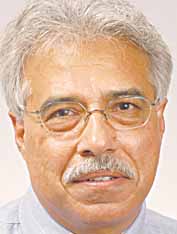YSU seeks feedback on strategic plan

YSU Provost and Vice-president of Academic Affairs Ikram Khawaja
By Denise Dick
YOUNGSTOWN
Development of a strategic plan designed to take Youngstown State University into 2020 is on track.
Eugene Grilli, YSU vice president of administration and finance, said information about the plan was distributed to trustees and members of the cabinet earlier this month, asking them to provide feedback and suggest amendments.
“We hope to have that to the board as soon as possible depending on the changes that have to be made,” said Grilli, who is co-chairman of the strategic planning committee along with Ikram Khawaja, provost and vice president of academic affairs.
A final document is expected to be presented early next year.
The plan comes at a critical time as YSU faces a $3 million reduction in state subsidies for the remainder of this current fiscal year and braces for an additional $7 million reduction in state funding next fiscal year. Next year’s reduction is because of the loss of federal stimulus dollars.
Scott Schulick, chairman of YSU trustees who also serves on the strategic planning committee, said the core and framework of the plan should be presented to the board next month.
Last summer, Cynthia Anderson, YSU president, asked Grilli and Khawaja to co-chair the committee and develop the plan.
The roughly 40-member committee identified five cornerstones on which to focus: student success, accountability and sustainability, urban-research transition, regional impact and communication.
Members selected the cornerstone upon which they wanted to concentrate and focus groups were conducted to gather additional input.
Khawaja believes the plan involved a good cross-section of participants.
Every cornerstone committee devised a list of people to participate and then determined where there was overlap. Input was also solicited online.
“Overall, I think the practice went very well,” the provost said.
“We tried to include all possible publics that we could think of to provide input,” Grilli noted.
That included people outside of the university as well.
“The plan embraces the situation that we find ourselves in as an institution as we move forward in the next decade under new leadership and the economic constraints of the state,” Schulick said.
The committee has done a good job in developing a plan in a short time, he said.
After the plan is approved by the board, Schulick said the real work begins.
“From there, the real work is to develop an implementation plan and associated time schedule,” he said. “The board is in concert with the president that this is something we’re going to work from. It’s not going to sit on a shelf. From that, we’re going to derive most of our decision-making as we move forward.”
 43
43
